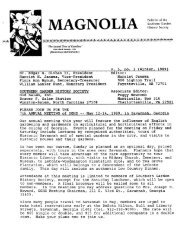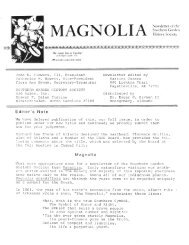Magnolia Newsletter Fall 04 - Southern Garden History Society
Magnolia Newsletter Fall 04 - Southern Garden History Society
Magnolia Newsletter Fall 04 - Southern Garden History Society
Create successful ePaper yourself
Turn your PDF publications into a flip-book with our unique Google optimized e-Paper software.
Adina de Zavala – …<br />
(continued from page 4)<br />
“Augustine de Zavala house moved by barge from Buffalo Bayou to Galveston,<br />
ca 1867” - De Zavala (Adina Emilia) Papers - Center for American <strong>History</strong> -<br />
The University of Texas at Austin - CT 0601<br />
and studied music at a school in Missouri. She taught school in<br />
Terrell, Texas and then, for many years, in San Antonio.<br />
She was a member of the Texas Folklore <strong>Society</strong> and swapped<br />
stories with J. Frank Dobie and Alan Lomax. She corresponded<br />
with Elizabeth Ney, the sculptor whose representations of heroes of<br />
Houston and Austin grace the State Capitol. Adina was a member<br />
of the Texas Philosophical <strong>Society</strong> and a founding member of the<br />
Texas State Historical <strong>Society</strong>. She corresponded with governors<br />
and legislators and was very much a part of the social and cultural<br />
scene of her time.<br />
Adina’s most significant work, however, was in the field of<br />
preservation. She formed one of the first patriotic organizations in<br />
the state in 1889. This group later became the De Zavala Chapter<br />
of the Daughters of the Republic of Texas. She was largely<br />
responsible for saving the Alamo long barracks from destruction.<br />
That is a story unto itself, and her confrontation with wealthy<br />
young Clara Driscoll over preservation matters was dubbed the<br />
“Second Battle of the Alamo.” During this battle, in 1908, Adina<br />
even locked herself in the barracks and refused to come out for<br />
three days! Officials allowed her only water, not the coffee and<br />
breakfast her friends wanted to bring her. 10<br />
Bebe and Mary Fenstermaker, who resided near San Antonio<br />
and whose grandmother, mother, and aunt knew Adina, described<br />
her with the utmost esteem:<br />
“Miss Adina really went to bat for the Alamo<br />
Long Building which everyone wanted to tear<br />
down because the general thought was that it<br />
wasn’t original. Our family had a history of<br />
trying to save the building and of course Miss<br />
Adina’s efforts were supported by the family.<br />
Now it has been pretty well proven that the<br />
Long Building was a part of the complex and<br />
Miss Adina is given the credit for saving it. She<br />
took a stand, held fast and that was, in those<br />
days, a difficult thing for anybody to do. People<br />
called her crazy. We were assured by our<br />
grandmother, mother, and aunt that that term<br />
was something often said about one<br />
if they took a stand opposite the entrenched<br />
thought. But it was just a thing that one had to<br />
do—you got up off the soft sofa and acted—if<br />
you wanted something saved or changed.” 11<br />
After her Alamo battle, the Daughters of the Republic of<br />
Texas (DRT) was split into factions and eventually the De Zavala<br />
Chapter ceased to exist. In 1912, Adina formed the Texas<br />
Historical Landmark Association, which through the years marked<br />
thirty-eight different historical sites. In 1915 she began her<br />
campaign on behalf of the Spanish Governor’s Palace in San<br />
Antonio. Her colorful articles describing the bedraggled looking<br />
building as a Spanish Governor’s Palace eventually led to its<br />
restoration. The fact that no Spanish Governor ever even got near<br />
San Antonio didn’t bother her.<br />
In Spanish records the structure is called the “casa de capitan”<br />
and was used as the military headquarters, but Adina translated<br />
that into “Spanish Governor’s Palace.” The City of San Antonio<br />
purchased the building in 1928 after more than a dozen years of<br />
needling by Adina. By 1930 it was open to the public and today it<br />
is one of the favorite tourist spots in San Antonio. While its<br />
restoration authenticity may be questionable, according to Kenneth<br />
Hafertepe, it is the only remaining piece of residential architecture<br />
existing from the Spanish Colonial period in San Antonio. As he<br />
said, “De Zavala blended myth and history together in the service<br />
of preservation…” 12<br />
“Home of Adina’s mother Mrs. Julia K. de Zavala at 117 4th St., San<br />
Antonio” - De Zavala (Adina Emilia) Papers - Center for American <strong>History</strong><br />
The University of Texas at Austin - CT 0602<br />
In addition to her newspaper articles, Adina also wrote a<br />
number of pamphlets and short stories. In 1917, she self-published<br />
her book, <strong>History</strong> and Legends of the Alamo and Other Missions in<br />
and around San Antonio. Richard Flores, professor of Anthropology<br />
and Chicano Studies at the University of Wisconsin-Madison,<br />
edited a reprint of her book in 1996 and wrote eloquently and<br />
(continued on page 6)<br />
Vol. XIX, No. 3 <strong>Magnolia</strong> • <strong>Fall</strong> 20<strong>04</strong> 5
















